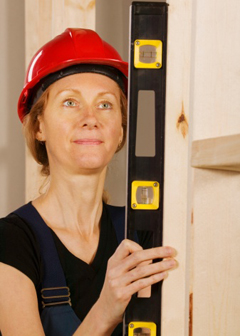
Apprentice carpenters learn by working with more experienced coworkers.
Carpenters typically need a high school diploma and learn on the job or through apprenticeships.
Education
A high school diploma or equivalent is typically required to enter the occupation. Certain high school courses, such as mathematics and mechanical drawing, may be useful. Some vocational-technical schools offer associate’s degrees in carpentry. The programs vary in length and teach basics and specialties in carpentry.
Training
Carpenters typically learn on the job or through apprenticeships. They often begin doing simple tasks, such as measuring and cutting wood, under the guidance of experienced carpenters or other construction workers. They then progress to more complex tasks, such as reading blueprints and building wooden structures.
Several groups, such as unions and contractor associations, sponsor apprenticeship programs. For each year of a typical program, apprentices must complete a predetermined number of hours of technical training and paid on-the-job training. Apprenticeship program requirements differ based on the type of program and by region. Apprentices learn carpentry basics, blueprint reading, mathematics, building code requirements, and safety and first aid practices. They also may receive specialized training in creating and setting concrete forms, rigging, welding, scaffold building, and working within confined workspaces. All carpenters must pass the Occupational Safety and Health Administration (OSHA) 10-hour safety course.
Work Experience in a Related Occupation
Some carpenters work as construction laborers or helpers before becoming carpenters. Laborers and helpers learn tasks that are similar to those of carpenters.
Licenses, Certifications, and Registrations
Carpenters may need a driver’s license to travel to jobsites.
Optional programs offer certification by specialty that may allow carpenters to find additional work opportunities or lead to career advancement. Information on certifications is available from CareerOneStop.
Advancement
Carpenters are involved in many phases of construction and may have opportunities to become first-line supervisors, lead carpenters, independent contractors, or general construction supervisors.
Important Qualities
The following are examples of qualities that are important for these workers to perform their duties. For more information, visit the Employment Projections (EP) skills data page.
Business skills. Self-employed carpenters must conduct activities such as bidding on new jobs, tracking inventory, and directing workers.
Detail oriented. Carpenters must be able to precisely cut, measure, and modify the materials they work with.
Dexterity. Carpenters use many tools and need hand-eye coordination to avoid injuring themselves or damaging materials.
Interpersonal skills. Carpenters need to work as a member of a team, cooperating with and assisting others. They also may interact with customers.
Math skills. Carpenters frequently use math skills, including basic trigonometry, to calculate the area, size, and amount of material needed for the job.
Physical strength. Carpenters use heavy tools and materials that weigh up to 100 pounds. They also must be able to stand, climb, or bend for many hours.
Problem-solving skills. Carpenters may work independently with little guidance. They need to be able to modify building materials and make adjustments onsite to complete projects.
Reading comprehension skills. Carpenters need advanced reading ability to understand and follow complex instructions for installing certain products, such as doors.
 United States Department of Labor
United States Department of Labor











